Handoffs, sequential dependencies, inefficient approval processes, sound familiar? Indeed, organizational roadblocks can be found everywhere. Knowing how you create value is essential, but finding what's preventing delivery is key to enabling lasting improvements and greater efficiency.
In this line of thought, constraints and bottlenecks are the main limiting factors of every process.
Having said that, reading an article on the Agile transformation myth by organizational design expert and former Chief of Agile at Toyota - Nigel Thurlow sparked an interesting discussion among our team on this topic.
Are bottlenecks and constraints the same thing? If not, what's the difference? Let's explore more.
What Is a Constraint?
A constraint is a limiting factor to a process and can impact organizational performance. A work process constraint, for instance, restricts the ability of a system to achieve its goals. By identifying work process constraints, organizations can improve how work is delivered and become more efficient.
How the Theory of Constraints Defines Constraints?
Constraints are defined originally in the Theory of Constraints (TOC) by Dr. Eliyahu Goldratt in 1984 - a scientific approach to system improvement based on identifying the limiting factors of a system. The theory states that every system has at least one limiting constraint, and focusing on utilizing it is the most efficient way to improve the outputs of that system.
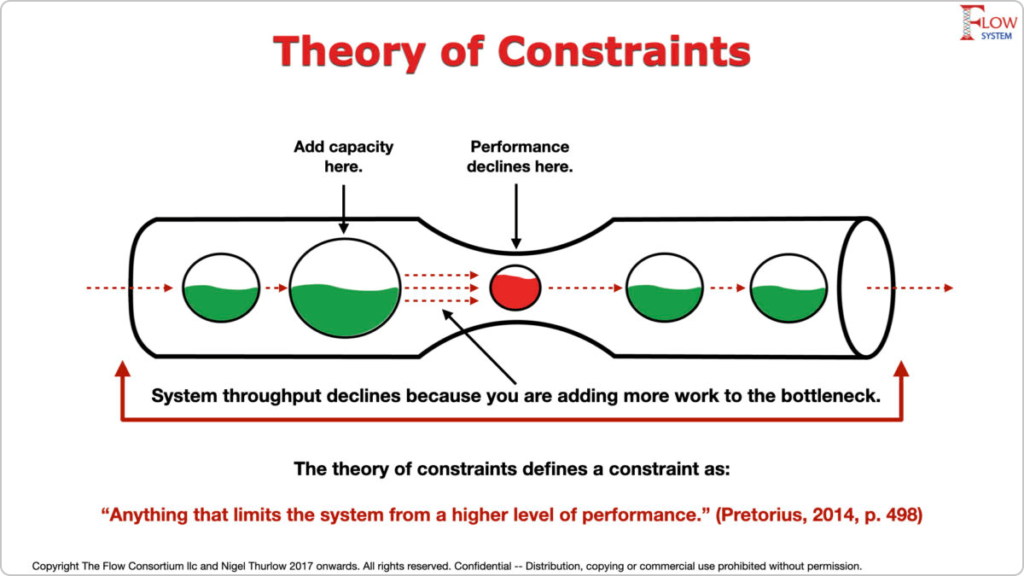
Visualization example of the Theory of Constraints, Image credit: Flow System
According to the theory, constraints can be physical, such as a bottleneck in a manufacturing process (ex., limited workload capacity of a machine), or non-physical, such as compliance rules, regulations, or organizational policies that hinder performance.
The most common limiting factors in project management, for instance, include time, cost, and scope, known as the Project Management Triangle. It is important to note that these can have a significant impact on your successful project delivery.
What Are Bottlenecks?
Bottlenecks are factors or resources with limited capacity than what's necessary to meet demand. A typical example of a process bottleneck is a work stage that receives more requests than it can process at its maximum capacity. Such bottlenecks are likely to cause delays across the entire flow of work. Other common bottlenecks include waiting on approvals from third parties, dependencies, or frequent reworks. Understanding capacity is an important part of dealing with bottlenecks.

Identifying a process bottleneck
Bottlenecks and Constraints Examples
To give you more perspective into constraints and bottlenecks, let's illustrate both with an example.
In the financial domain, for instance, regulatory compliance requirements are often strict and complex, which can cause delays in the process. Organizations need to ensure that they comply with regulatory requirements to avoid penalties, which can result in a backlog of work and delays in the overall process. So, in that case, the regulatory compliance procedures present a constraint that can limit how quickly the process flows.
On the other hand, applying for a loan typically involves a few-step process, including credit and background checks, verification of income sources, and more. If the background check phase, for instance, takes longer than expected due to limited capacity, that would cause a backlog of loan applications and longer lead times for customers. In that scenario, the background checks stage is the bottleneck in the loan approval process.
System Constraints vs. Process Bottlenecks
As shown in the example, process bottlenecks and constraints are both factors that limit the capability of a process to deliver on time. However, while constraints can be categorized as limitations or bottlenecks, not every bottleneck is necessarily a constraint. Let's see how.
As highlighted, a bottleneck is a capacity-related restriction, while a constraint is a wider organization limiting factor.
On the one hand, bottlenecks create a backlog of work that slows down the overall process and can occur for various reasons, such as equipment breakdowns, multiple dependencies, or too much work in progress.
On the other hand, constraints have a wider impact and can hinder the entire system's performance. Having a limited budget, for instance, can be a constraint causing delays, impeding optimal value delivery, or even driving lesser quality.
| Constraints | Bottlenecks |
|---|---|
| Limiting factors that can impact organizational performance and the ability to achieve goals | A specific stage or factor in a process where the capacity is less than the demand, causing delays |
| Can be physical (like a machine's limited capacity) or non-physical (like compliance rules or organizational policies) | Typically associated with a specific process stage and is often capacity-related |
| Defined in the Theory of Constraints (TOC) | Often identified by examining stages in a process where work piles up or slows down |
| Can be enabling or inhibiting; enabling constraints can lead to positive effects by improving throughput and productivity | Focused on optimizing capacity and aligning it with demand to alleviate waiting queues and improve efficiency |
Are All Constraints Negative?
An interesting discussion is whether all constraints are related to slower performance. According to the Flow System, some constraints bear positive nuances.
For example, inhibiting constraints, such as regulatory rules, directives, or strict organizational hierarchy, usually don't add any value and are regarded as restricting and limiting to everyone involved.
However, there are enabling constraints that can bring positive effects to your system. Limiting the work in progress in a system, for instance, can seem like a limiting constraint on the surface as it implies not utilizing your full capacity. However, by limiting the amount of work in progress, you can ultimately improve your team's overall throughput rates and the productivity of your system.
Let's see how both can be identified.
How to Identify Bottlenecks in 3 Steps Using a Digital Board?
Powerful workflow management can enable organizations to maximize efficiency and gradually improve. One way to achieve this is to opt for a meticulous mapping of every value delivery process. A comprehensive workflow management board is a good start.
Here's how using Kanban and a kanban board can help you elevate the visibility of the flow of your work and identify weak links in your system in three steps:
1. Visualize the Flow of Work
Visualizing your workflow on a kanban board allows you to see the risks and specifications of your workflow. This way, you can see where work items pile up so you can make the necessary improvements.
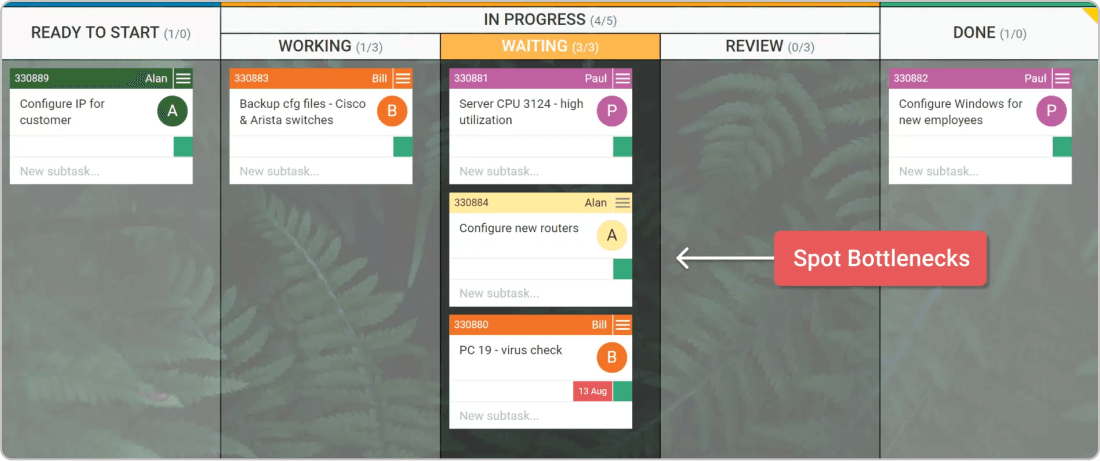 Visualizing the flow of a work process on a digital project management board in Businessmap
Visualizing the flow of a work process on a digital project management board in Businessmap
2. Map All Work Stages in Your Process
By visualizing an end-to-end work process, including the waiting stages, a kanban board will help you understand how long work stays idle in the queuing stages and how long it spends in value-adding process steps.
Once you understand how work flows in the process, it is a good practice to limit the work in progress. This can help you restrict how much work teams take on, alleviate huge waiting queues, and ultimately optimize capacity levels to align incoming demand with actual capabilities.
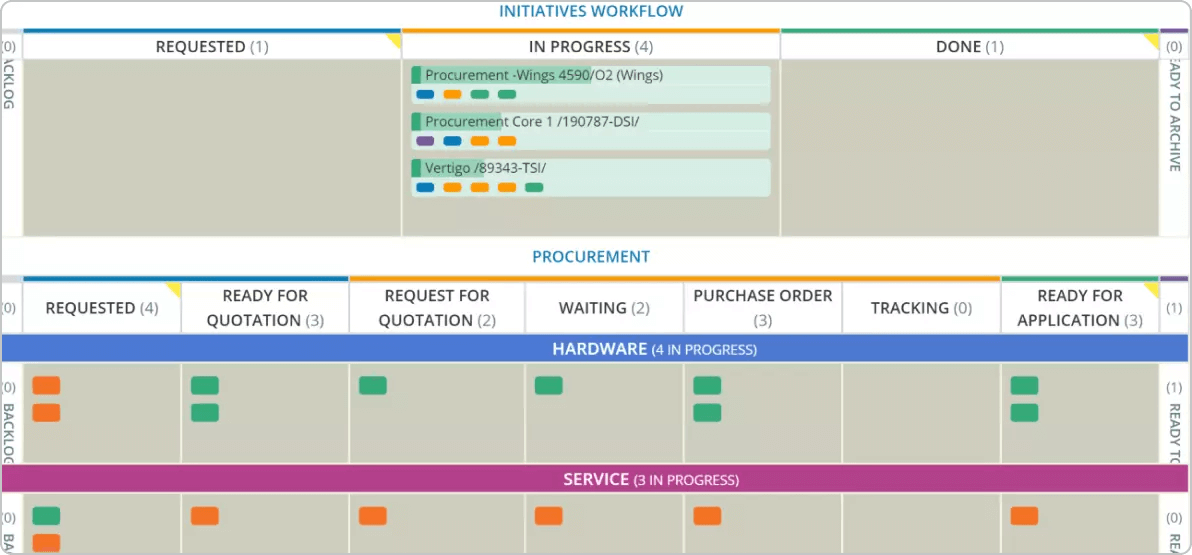 Visualizing an end-to-end delivery process, including work-in-progress limits in Businessmap
Visualizing an end-to-end delivery process, including work-in-progress limits in Businessmap
3. Measure Your Cycle Time
Measuring the cycle times in your process will help you better understand the steps where the actual value is created. By analyzing where work takes the most time, you can uncover the process steps that hinder your teams' workflow efficiency.
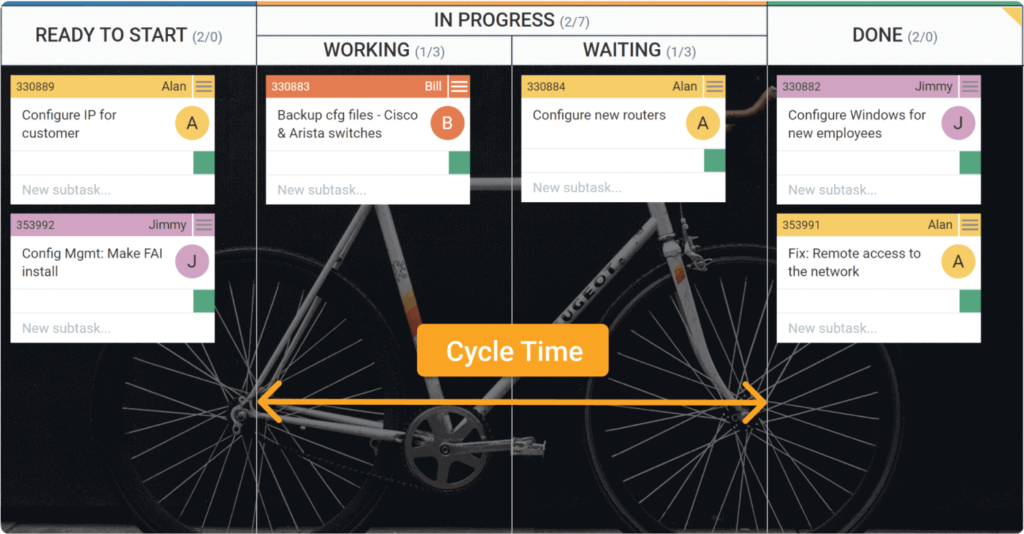
Working process stages and cycle time indication on a project management board in Businessmap
How to Identify Constraints Using the 5 Focusing Steps Process?
The TOC proposes a five-step process for identifying and addressing constraints, known as the Thinking Process. This process involves the following steps:
1. Identifying the system's constraint. Finding where the real constraint lies in your process can be the single most critical factor to achieving your organizational goals. A successful or failed initiative to improve efficiency or gain customer satisfaction can depend on whether you identify the weak link in your system correctly.
2. Exploit the constraint. Analyze the constraint in detail to understand its outputs and use them to your advantage. As a result, you can understand the root cause of your system's constraints and eliminate them permanently.
3. Subordinate everything else to the constraint. Avoid producing more than the constraint can handle. Aligning your process capacity with the constraint's capacity can help you ensure maximum performance, as the system itself would support the constraint's capabilities.
4. Elevate the constraint. Once you have exploited the constraint to its maximum, you can continue to improve your system by adding additional resources to it. You may want to invest in equipment, tools, people, etc.
5. Prevent inertia from becoming a constraint. Elevate other constraints by repeating the steps on your path to continuous improvement.
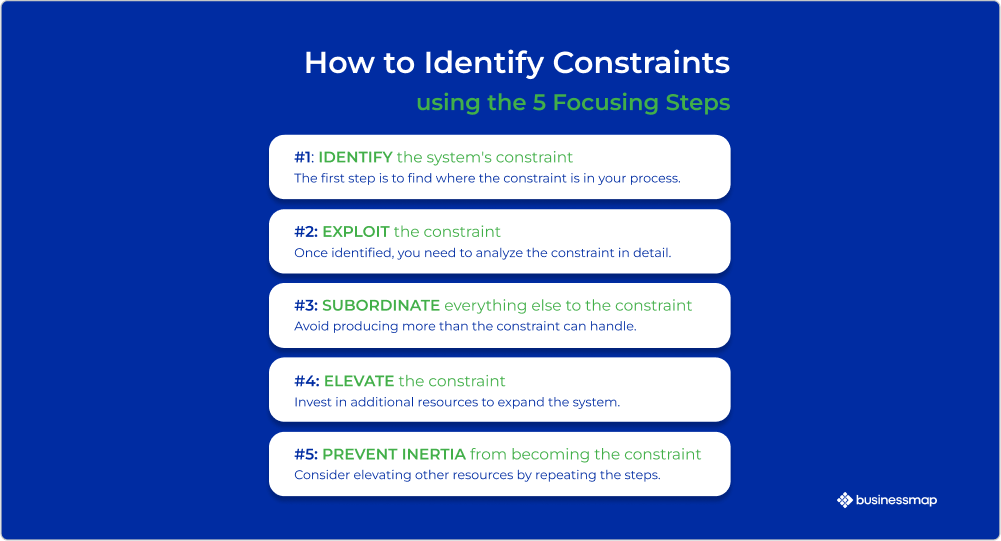
5 Focusing Steps process to identifying constraints
Enable Organizational Agility by Recognizing Your System's Limitations
Successful organizations today aim to be agile and responsive to change. As companies try to achieve agility, they tend to work as a network of interconnected services with cross-connected teams and multiple dependencies. In such an environment, it is crucial to understand the factors limiting your process.
Identifying the bottlenecks in your system and learning from the constraints can significantly impact your entire value delivery process. When used to their full potential, bottlenecks and constraints can be powerful enablers of organizational agility.

Iva Krasteva
Content Strategist | Agile Practitioner | Kanban Certified
Iva is a Kanban-certified Agile expert with hands-on experience in SEO, content creation, and Lean practices. She has published dozens of articles on Lean, Agile, and Kanban practical applications. Iva actively promotes collaborative, flexible work environments and regularly shares process optimization insights through writing.



